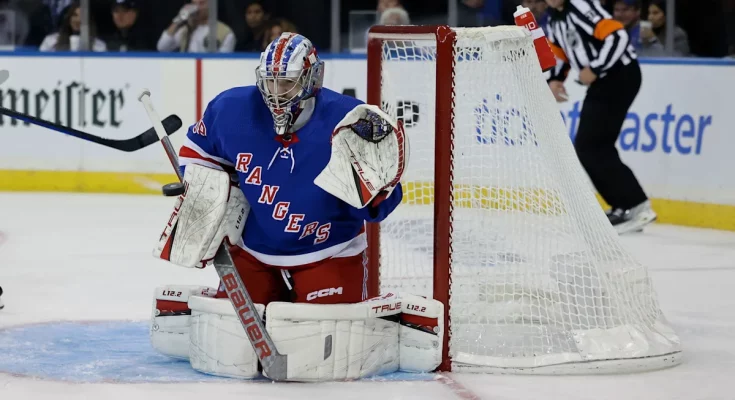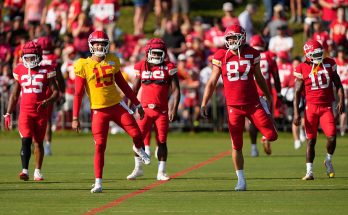Dylan Garand’s rise to stardom is one of those rare stories in hockey where timing, talent, and unshakable confidence align so perfectly that it becomes impossible for a franchise to ignore. For the New York Rangers, who have long been blessed with a rich goaltending history, Garand’s emergence is no longer just a promising subplot—it’s rapidly becoming a central storyline that could reshape the team’s future plans. Once considered a developmental project with potential, he is now making the kind of impression that forces management to take notice and reevaluate the goaltending depth chart. His journey from an overlooked prospect to a rising star has been marked by persistence, discipline, and the ability to shine when it matters most. In a city like New York, where the pressure can chew up even seasoned veterans, Garand is showing he has both the mental toughness and the skill to thrive.
What makes Garand’s rise so intriguing is that he has developed without the benefit of overwhelming hype. He was not the top draft pick who was expected to step in and carry the team’s future on his shoulders. Instead, he arrived with modest expectations, and over time he has chipped away at every doubt, replacing them with highlight-reel saves, statistical consistency, and a growing confidence that radiates both on and off the ice. For the Rangers, who already have a franchise cornerstone in Igor Shesterkin, Garand’s progression is a luxury problem—one of the best kinds to have in professional sports. It’s not often that a team can legitimately say they have two potential starting-caliber goaltenders, but Garand’s recent performances are making that a reality.
What stands out most about Garand is not just his technique, but his poise in high-pressure situations. Goaltending at the NHL level is as much mental as it is physical, and Garand’s ability to remain composed during chaotic sequences in front of the net has been a defining feature of his game. His lateral quickness allows him to track the puck across the crease with precision, and his glove hand has become a genuine weapon against opposing shooters. Beyond the raw skills, there’s a confidence in his decision-making—whether it’s challenging shooters at the top of the crease or controlling rebounds to prevent second-chance opportunities—that reflects a maturity beyond his years.
The Rangers’ coaching staff has been vocal about Garand’s work ethic and how it’s translated to steady improvement. His progression hasn’t been linear—like most young players, he’s had nights where the puck just didn’t bounce his way—but what separates him from others is how quickly he bounces back. That resilience is critical in New York, where the spotlight can be as unforgiving as it is bright. Whether he’s been playing in the AHL or getting opportunities in preseason action, Garand has shown that he’s not easily rattled. His calm demeanor off the ice matches his composure on it, making him a natural fit for the intense media market that comes with wearing a Rangers sweater.
Garand’s recent run of form has coincided with an uptick in speculation about his role moving forward. While no one is suggesting that Shesterkin is in danger of losing his status as the Rangers’ number one, there’s a growing sense that Garand could play a much larger role in the near future than originally anticipated. In today’s NHL, the days of a single goaltender starting 65-plus games are becoming rarer, and teams are placing more value on a strong tandem approach. That reality could open the door for Garand to see significant NHL action sooner rather than later.
There’s also the fact that injuries, schedule congestion, and the grueling nature of the season often force teams to rely heavily on their backup goaltenders. If Garand continues on his current trajectory, the Rangers could find themselves in a position where they not only trust him to spot-start against weaker opponents but also to take the net in meaningful games against playoff-caliber teams. That’s the kind of confidence that has to be earned, and Garand is earning it shift by shift, save by save.
From a developmental standpoint, Garand has benefited greatly from the Rangers’ goaltending coaching staff, who have helped refine his technique without trying to overhaul his natural instincts. Too often, young goalies lose their edge when they’re over-coached, but Garand has struck a balance between structure and creativity in his game. His ability to read plays before they fully develop allows him to position himself more effectively, reducing the need for desperation saves. This foresight is part of what makes his game so efficient—he’s rarely out of position, which not only makes him more effective but also helps conserve energy over the course of a long season.
Fans have taken notice too. At Madison Square Garden and in online Rangers communities, there’s growing buzz about Garand’s potential, with many believing he could eventually take on a role similar to what Jaroslav Halák provided in his prime years—a dependable, starting-caliber goaltender capable of stepping into the spotlight when needed. The difference is that Garand’s ceiling might be even higher. While it’s premature to predict that he will one day supplant Shesterkin, the fact that the conversation is even happening speaks volumes about how far he has come in such a short period.
Another factor in Garand’s rise is the changing landscape of NHL roster construction. In a salary-cap league, having two strong goaltenders on cost-effective contracts can give a team a competitive edge. If Garand continues to outperform expectations while on an entry-level deal, it could allow the Rangers to allocate resources elsewhere, strengthening the roster without compromising in net. That kind of roster flexibility can be the difference between a deep playoff run and an early exit. It’s no wonder that management is keeping a close eye on him.
Garand’s journey is also a testament to the importance of patience in player development. It’s easy for fans and media to write off prospects who don’t make an immediate jump to the NHL, but Garand has shown that steady, incremental improvement can eventually lead to a breakout. His time in the minors has clearly served him well, giving him the chance to refine his skills without the constant scrutiny and pressure of the NHL. Now, as he transitions into more prominent opportunities, it’s evident that the foundation laid in those years is paying off.
Looking ahead, the biggest challenge for Garand will be maintaining his upward trajectory in the face of heightened expectations. Once a player establishes themselves as a legitimate NHL option, the margin for error shrinks. Opponents will have more video on him, and shooters will start to look for patterns in his game. How he adjusts to those countermeasures will be the true test of his staying power. Given what we’ve seen so far—his adaptability, his mental toughness, and his willingness to put in the work—there’s every reason to believe he’s up for the challenge.
For now, the Rangers have the luxury of letting the situation play out without rushing a decision. But each stellar performance by Garand adds to the sense that he won’t be content to simply wait his turn indefinitely. In a league where opportunities can be fleeting, his determination to seize the moment is exactly what you want in a young goaltender. If his current trajectory continues, the question won’t be whether Dylan Garand is ready for the NHL—it will be how the Rangers plan to make room for him in a crease already occupied by one of the league’s best.
In the end, the emergence of Dylan Garand is not just a feel-good story about a young player making his mark. It’s a potential turning point for the Rangers’ long-term goaltending strategy. With his combination of skill, poise, and relentless drive, Garand has transformed himself from a promising prospect into a legitimate NHL-caliber netminder. And in doing so, he’s made himself impossible to ignore. The Rangers may not have planned for this competition in goal, but they now find themselves in the enviable position of having two exceptional options. For a franchise that understands the value of elite goaltending, it’s a challenge they’ll gladly embrace. Because if Dylan Garand keeps playing like this, his future won’t just be in the Rangers’ plans—it will be at the very center of them.



